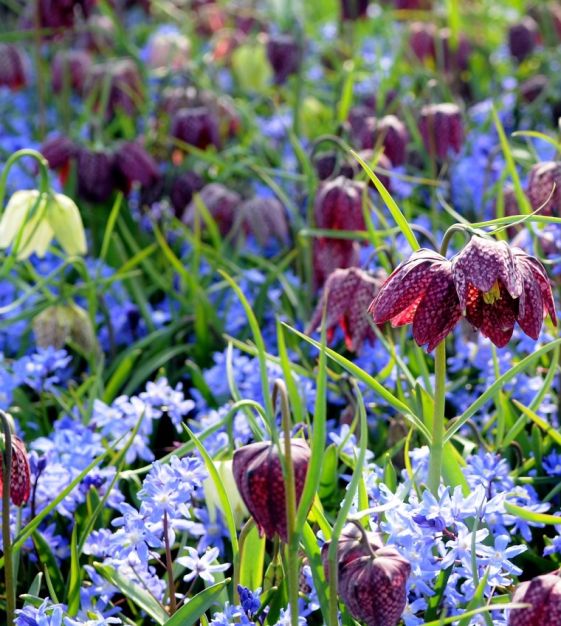-
- Discounted Collections
- 20%-Off Website Specials
- New for 2024!
- Tulips
- Narcissi
- Allium
- Anemone blanda
- Brodiaea
- Camassia
- Chionodoxa
- Corydalis
- Crocus
- Eranthis
- Eremurus
- Erythronium
- Fritillaria
- Galanthus
- Geranium
- Gladiolus
- Hyacinths
- Hyacinthoides
- Ipheion uniflorum
- Dutch Iris
- Rock Garden Iris
- Ixiolirion
- Leucojum aestivum
- Muscari
- Ornithogalum
- Oxalis
- Puschkinia
- Scilla
- Lilies
- Peonies
- Amaryllis
- Paperwhites
- Tender Bulbs
- Anemone Giants
- Tecolote Ranunculus
- Freesias
Fritillaria meleagris
Commonly known as The Guinea Hen Flower, The Checkered Lily or The Snake’s Head Fritillary, F. meleagris is an heirloom species dating back to 1575. It has pendant, bell-shaped, checkered and veined flowers that are either maroon or ivory-white with grass-like foliage intermittently spaced on its slender stems. This deer- and rodent-resistant naturalizer is native to the western Himalayas and Asia Minor, and prefers rich, well-draining neutral pH soil and a bit of light shade or dappled sunlight. Mature plantings can grow taller than its usual 8” height, usually 10" to 12". You’ll need about nine bulbs per square foot. Bulb size: 6 cm/up. Full to partial sunlight. Bloom time in horticultural zone 5: April/May. Plant 5" to 6" deep and 5" to 6" apart. HZ: 3-8. Height: 10" to 12".
Fritillaria are The Art & Soul of Spring.
Fritillaria Horticultural Tips Stinze Plantings
Fritillaria are The Art & Soul of Spring.
Fritillaria Horticultural Tips Stinze Plantings
- Information
Fritillaria
Deer- and rodent-resistant Fritillaria have ivory, yellow, green, plum or two-tone pedant, bell-shaped flowers. Growing from 8" to 36" tall with a bit of a skunky scent, most of our Fritillaria were native to the western Himalayas and Asia Minor from 1575 through 1905. They prefer rich, well-draining neutral pH soil and filtered sunlight. A bit more finicky than other flower bulbs, these heirlooms don't like being out of the soil, so plant them immediately upon receipt. Bulb sizes depend upon the variety. Bloom time: April/May. Plant the large Fritillaria bulbs 6" to 7" deep and 8" to 10" apart. Plant the smaller Fritillaria bulbs 5" to 6" deep and 5" to 6" apart. Variable horticultural zones ranging from 3-8 depending on the variety.
Fritillaria are The Art & Soul of Spring.
Fritillaria Horticultural Tips
Deer- and rodent-resistant Fritillaria have ivory, yellow, green, plum or two-tone pedant, bell-shaped flowers. Growing from 8" to 36" tall with a bit of a skunky scent, most of our Fritillaria were native to the western Himalayas and Asia Minor from 1575 through 1905. They prefer rich, well-draining neutral pH soil and filtered sunlight. A bit more finicky than other flower bulbs, these heirlooms don't like being out of the soil, so plant them immediately upon receipt. Bulb sizes depend upon the variety. Bloom time: April/May. Plant the large Fritillaria bulbs 6" to 7" deep and 8" to 10" apart. Plant the smaller Fritillaria bulbs 5" to 6" deep and 5" to 6" apart. Variable horticultural zones ranging from 3-8 depending on the variety.
Fritillaria are The Art & Soul of Spring.
Fritillaria Horticultural Tips
Fritillaria
Deer- and rodent-resistant Fritillaria have ivory, yellow, green, plum or two-tone pedant, bell-shaped flowers. Growing from 8" to 36" tall with a bit of a skunky scent, most of our Fritillaria were native to the western Himalayas and Asia Minor from 1575 through 1905. They prefer rich, well-draining neutral pH soil and filtered sunlight. A bit more finicky than other flower bulbs, these heirlooms don't like being out of the soil, so plant them immediately upon receipt. Bulb sizes depend upon the variety. Bloom time: April/May. Plant the large Fritillaria bulbs 6" to 7" deep and 8" to 10" apart. Plant the smaller Fritillaria bulbs 5" to 6" deep and 5" to 6" apart. Variable horticultural zones ranging from 3-8 depending on the variety.
Fritillaria are The Art & Soul of Spring.
Fritillaria Horticultural Tips
Deer- and rodent-resistant Fritillaria have ivory, yellow, green, plum or two-tone pedant, bell-shaped flowers. Growing from 8" to 36" tall with a bit of a skunky scent, most of our Fritillaria were native to the western Himalayas and Asia Minor from 1575 through 1905. They prefer rich, well-draining neutral pH soil and filtered sunlight. A bit more finicky than other flower bulbs, these heirlooms don't like being out of the soil, so plant them immediately upon receipt. Bulb sizes depend upon the variety. Bloom time: April/May. Plant the large Fritillaria bulbs 6" to 7" deep and 8" to 10" apart. Plant the smaller Fritillaria bulbs 5" to 6" deep and 5" to 6" apart. Variable horticultural zones ranging from 3-8 depending on the variety.
Fritillaria are The Art & Soul of Spring.
Fritillaria Horticultural Tips





